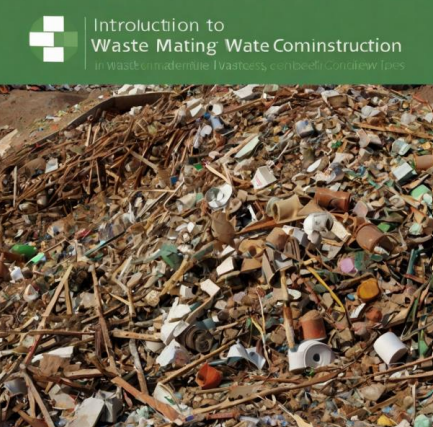
Welcome to the first lesson of our course on Waste Management and Recycling in Construction. Today, we will cover an essential topic: the
different types of waste generated on construction sites. Understanding these waste types is the foundation for effective waste management
strategies.
Learning Objectives
By the end of this lesson, you will be able to:
Identify the common types of waste generated on construction sites.
Understand the sources and characteristics of each waste type.
Recognize the impact of each waste type on the environment and the importance of proper management.
Types of Construction Waste
Construction projects generate various types of waste, which can be broadly categorized into the following:
1. Concrete and Masonry Waste
Sources: Demolition of old buildings, excess concrete from mixing, damaged bricks, and masonry.
Characteristics: Heavy, bulky, and often recyclable.
Impact: If not managed properly, it can contribute significantly to landfill volume and require substantial disposal costs.
2. Wood Waste
Sources: Off-cuts from framing, broken pallets, temporary structures, and formwork.
Characteristics: Organic material, often recyclable or reusable, but can rot if left untreated.
Impact: Can be recycled into new wood products or used as biomass fuel. Improper disposal can lead to environmental
degradation.
3. Metal Waste
Sources: Off-cuts from steel, aluminum, and other metals used in construction and demolition.
Characteristics: Valuable recyclable material, includes ferrous (iron, steel) and non-ferrous (aluminum, copper) metals.
Impact: Recycling metal waste can save significant amounts of energy compared to producing new metals. Improper
disposal can result in resource wastage.
4. Plastic Waste
Sources: Packaging materials, piping, insulation, and discarded plastic components.
Characteristics: Lightweight, non-biodegradable, often recyclable.
Impact: Plastics can take hundreds of years to decompose in landfills, posing a long-term environmental hazard. Recycling
can mitigate these impacts.
5. Glass Waste
Sources: Windows, glass doors, and fixtures.
Characteristics: Breakable, can be recycled into new glass products.
Impact: Glass waste is inert and doesn’t decompose, but recycling it reduces the need for raw materials and energy
consumption.
6. Hazardous Waste
Sources: Paints, solvents, adhesives, asbestos-containing materials, and chemicals.
Characteristics: Dangerous to human health and the environment, requires special handling and disposal.
Impact: Can contaminate soil and water, posing significant health risks. Proper disposal is critical to prevent
environmental contamination.
7. Gypsum (Drywall) Waste
Sources: Off-cuts from drywall installation, damaged or excess drywall.
Characteristics: Can be recycled into new drywall or used as a soil amendment.
Impact: Improper disposal can lead to harmful gas emissions in landfills. Recycling reduces environmental impact.
8. Miscellaneous Waste
Sources: Mixed materials from demolition, renovation, and site clearance.
Characteristics: Varies widely, may include a mix of recyclable and non-recyclable materials.
Impact: Sorting and separating these materials can enhance recycling rates and reduce landfill use.
Importance of Proper Waste Management
Environmental Impact:
Construction waste contributes significantly to landfill volumes, leading to soil and water contamination.
Proper recycling and disposal help conserve natural resources and reduce pollution.
Economic Benefits:
Recycling materials can reduce disposal costs and generate revenue from recyclable materials.
Efficient waste management can improve project profitability and sustainability.
Regulatory Compliance:
Adhering to waste management regulations is essential to avoid legal penalties and fines.
Compliance ensures safe and responsible disposal practices.
Conclusion
Understanding the different types of construction waste is crucial for implementing effective waste management practices. By identifying and
categorizing waste types, we can develop targeted strategies to reduce, reuse, and recycle materials, leading to more sustainable construction
practices.